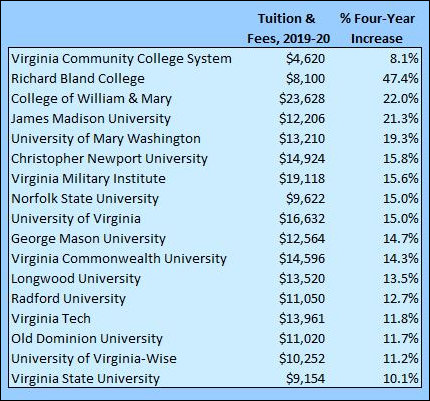
by James A. Bacon
What does it take to create an Opportunity Society? One critical element is providing Virginians with the skills they need to be employable in the occupations of the future. Nearly three out of five jobs created between now and 2026 will be “middle skill” jobs requiring community- or career-college training, not a four-year college degree. A majority of Virginians, therefore, will look to the Virginia Community College System (VCCS) for their ticket to the middle class.
Virginia’s community college system doesn’t get its due. The VCCS board is acutely aware of the affordability issue, and it has made it a priority to limit increases in tuition and fees. I thought it would be interesting to contrast the VCCS’s success in that regard to the runaway tuition-and-fees increases at Virginia’s public four-year residential colleges. I took the latest data from the State Council of Higher Education for Virginia (SCHEV) Tuition and Fees database to compare increases between the 2015-16 academic year and the current 2019-20 academic year.
You can see from the chart above that the community colleges have done a far superior job of keeping charges under control. Community colleges on average increased T&F only 8.1% over the four-year period compared to a range for the four-years of 10.1% for Virginia State University to 22% for the College of William & Mary. (Richard Bland, a two-year residential college is an extreme outlier.)
What accounts for the difference?
I would argue that the VCCS board has maintained a tight focus on its core educational mission of preparing students for those middle-skill occupations at an affordable cost. The community colleges have not engaged in mission creep. They have not leaped onto the hamster wheel of competing with other institutions for prestige and influence. They do not engage in the redistribution of income, inflating tuition for some to provide scholarships for others. They don’t create new bureaucracies to promote diversity — their student bodies are diverse to begin with. They are not investing in building expensive R&D programs. They are not vying for superstar faculty members who teach less and demand higher compensation. They aren’t continually building and upgrading their facilities — none, for example, are spending $10 million to renovate the president’s house.
(Caveat No. 1: The SCHEV figures above show the sticker price for attending Virginia’s public colleges and universities. All institutions make financial aid available, so the actual price paid may vary, depending upon the student’s family income. Caveat No. 2: I have not adjusted for changes in state support for each institution, which also varies by institution year to year.)
Community colleges remain affordable. Even without financial aid, a two-year degree will cost only $9,240 on average. That’s a pretty cheap ticket into a middle-class occupation.
The contrast between community colleges and the four-year colleges provides a tangible measure of how the public four-years have sacrificed the goal of an affordable education to the interest of building academic empires and boosting institutional prestige.
Seen in this light, while community colleges are contributors to the Opportunity Society, the public four-years are enemies of the Opportunity Society. By making access to higher ed so expensive, they are a significant cause of socioeconomic and racial inequity in Virginia. While championing “progressive” political causes and giving lip service to diversity, the most prestigious of the public four-years are run for the benefit of their administrative and faculty elites. Higher-ed is not the rule of the so-called 1%, the richest people in America, but it is the rule of the 2%, the extremely privileged and well-to-do. Considering the treatment of graduate students and adjunct faculty, public higher-ed is one of the most hierarchical and exploitative industries in the country.
In a recent post I explored James V. Koch’s ideas for reforming governance of Virginia’s public four-years. He lays much of the problem at the feet of complacent and ill-informed board members who are captured by wily college/university presidents. Perhaps Virginia should look to its community college State Board as a model.

Leave a Reply
You must be logged in to post a comment.